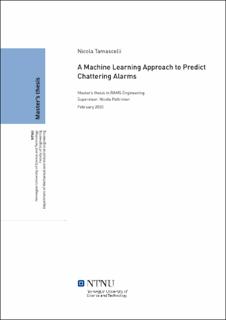| dc.description.abstract | The alarm system plays a vital role to grant safety and reliability in the process industry. Ideally, an alarm should inform the operator about critical conditions only, and a set of corrective actions should be associated with each alarm. During alarm floods, the operator may be overwhelmed by several alarms in a short time span. Crucial alarms are more likely to be missed during these situations. Poor alarm management is one of the main causes of unintended plant shut down, incidents and near misses in the chemical industry. Most of the alarms triggered during a flood episode are nuisance alarms –i.e. alarms that do not communicate new information to the operator, or alarms that do not require an operator action. Chattering alarms –i.e. that repeat three or more times in a minute, and redundant alarms –i.e. duplicated alarms, are common forms of nuisance. Identifying nuisance alarms is a key step to improve the performance of the alarm system. Advanced techniques for alarm rationalization have been developed, proposing methods to quantify chattering, redundancy and correlation between alarms. Although very effective, these techniques produce static results. Machine learning appears to be an interesting opportunity to retrieve further knowledge and support these techniques. This knowledge can be used to produce more flexible and dynamic models, as well as to predict alarm behaviour during floods. The aim of this study is to develop a machine learning-based algorithm for real-time alarm classification and rationalization, whose results can be used to support the operator decision-making procedure. Specifically, efforts have been directed towards chattering prediction during alarm floods. Advanced techniques for chattering, redundancy and correlation assessment have been performed on a real industrial alarm database. A modified approach has been developed to dynamically assess chattering, and the results have been used to train three different machine learning models, whose performance has been evaluated and discussed. | |
